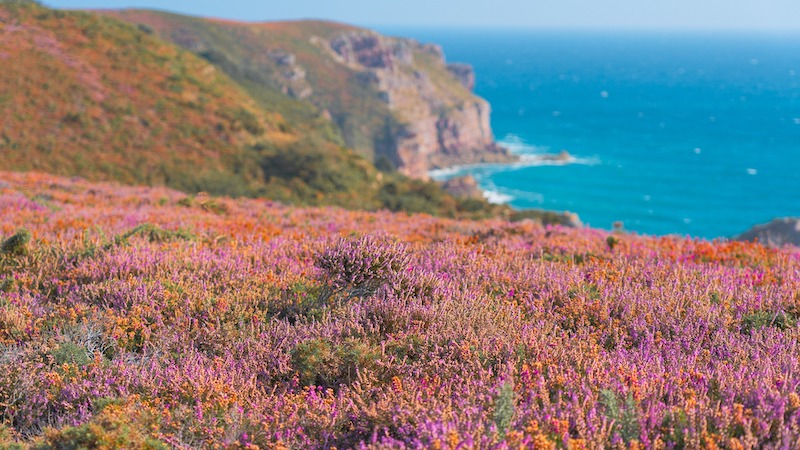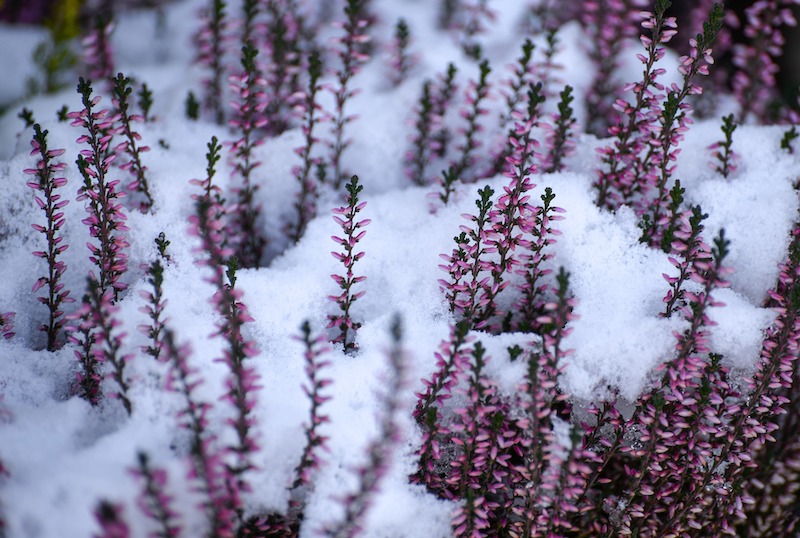Heather is a woody shrub that boasts dainty blooms in hues of purple or white. This bush starts to bloom in mid-summer, and while the flowers fall away in early fall, the scale-like evergreen foliage sticks around all year. The leaves usually turn a vibrant shade of red or orange during the fall when the temperatures cool. This European native provides year-round color and interest. Some Heather cultivars are winter hardy all the way into zone 4 or 5 but can also call zone 8 home.
Most shrubs are 1 to 2 feet tall and wide and thrive in full to partial sun. Heather is hardy and can easily handle less than ideal circumstances, like poor quality soil and salty conditions found in coastal areas. Heather is easy to grow and maintain, and water and pruning are perhaps the most important parts of caring for this perennial.

Planting Heather
Heather is a common sight in the moors of Scotland, which makes sense because this plant prefers acidic soil that is moist but well drained. This shrub is an excellent choice for erosion control along an embankment. Plants grown in colder zones will benefit from full sun, while plants grown in zones 6 through 8 prefer morning sun and afternoon shade. Heather prefers damp conditions, but high heat and humidity are too much for this plant to handle. This shrub is more likely to survive just outside of its northern zones than living outside the border of its southern zones.
Watering Heather
New Heather plants or recently transplanted shrubs need consistent water to help them acclimate. About one inch of water each week is enough to sustain growth. New plants exposed to extended drought conditions are not likely to recover. Established plants grown in zones 3 through 5 have average water needs. Plan to water these plants when the top couple inches of soil dry out. Plants grown in warmer regions will need more frequent watering.
Fertilizing Heather
Heather is not a heavy feeder. Amend the soil with organic compost during planting and top-dress the soil with organic matter each spring to support healthy growth. Additional fertilizer is not generally necessary. Advanced gardeners may want to test the soil to determine the pH. Apply an acidic fertilizer once annually in the early spring if the soil is not naturally acidic.
Pruning Heather
Pruning is an essential part of caring for Heather bushes. Trim the plant during the spring to create a more full and bushy appearance. Established plants can become overgrown and leggy, but pruning the plant maintains a more compact appearance and promotes new growth. Routine trims also help the plant grow faster, so it will have a more dense appearance which is ideal when using Heather to create a hedge or border.
Caring For Heather in Pots
Growing Heather in pots offers more flexibility regarding placement and growing zones. This bush does not need a deep container but prefers a wide pot. The container must have drainage because while this shrub appreciates damp conditions, it does not tolerate soggy soil. Potted Heather shrubs need care similar to bushes grown in beds or borders, except they will need water more often. Container-grown plants dry out more quickly, so plan to water potted Heather daily or every couple of days. Saturate the soil until excess water drains through the container.

Winter Care for Heather
Heather is winter hardy, but plants grown in northern areas will need protection during the winter. Large plants in cold areas should be covered to protect against the snow load. Pack pine straw or other organic matter around the base of the plant to insulate the roots from cold temperatures. Potted plants should be moved to a protected area. Heather plants grown in warmer regions will not need much winter care.

Common Heather Care Questions
Why Is My Heather Dying?
One of the main reasons for a dying heather plant is poor soil. Heathers prefer acidic soils with good drainage. Your struggling plant will thrive again, just make sure it is getting the nutrients it requires. If the soil is suitable, heathers can be adapted to survive and thrive long.
Will Heather Grow In Shade?
Planting heathers where they will enjoy 6+ hours of sunlight each day is best for foliage effect, with afternoon shade in hotter areas. Heathers will also grow successfully in light shade, but with too much shade, the blooms will become scarce, foliage color will be dulled and new growth spindly.
How Do I Keep Heather Blooming?
You do not need to deadhead heather floral spikes, but you can clip them off with pruners to encourage new growth once they fade. To encourage heather to bloom, make sure the plant has well-draining acidic soil. Heather needs at least six hours of sun a day.
Is Heather Drought Tolerant?
Heather is considered a drought tolerant plant once established, but only to a point. They must never completely dry out. If they look dry, they are already dead.
What To Do With Heather After It Blooms?
Prune Heather after blooming to refresh this shrub. Most heathers should be cut back to the base after flowering – they don't grow well from old wood, so discard any that have become woody and leggy. Cut them back as far as possible, without cutting into bare wood. Pruning this way will delay blooming for a couple of weeks, but it will stimulate bushy new growth, produce heavier flowering and, most important, prevent the plant from forming a bare, woody center.
Is Heather Edible?
Parts are edible. his is a plant best infused into liquid and then added to food. Try vinegars, or making a tea with which you then cook your rice, quinoa, barley or other grain.
Is Heather Invasive?
It is classified as invasive weed, in some areas of the world.
Is Heather An Annual Or Perennial?
Heather, commonly called Scotch Heather, is a small, woody perennial in the Ericaceae family.
Why Are Leaves On Heather Turning Yellow, Brown, and/or Black?
Generally, over and under watering is the culprit. There are also spider mites, which can quickly kill one of these plants. You will notice the leaves of the plant turning a yellow or brown color. You can keep these pests from becoming a problem by using a good insecticidal soap.
What Is the Growth Rate of Heather?
Within two years the heathers will have grown together and with proper trimming your garden will be easy kept and will have color all year round.
Have a question about Heather? Fill out the form below and we will try and get back to your question as soon as possible. We may even feature your question in this article to help other gardeners!
 |
Author Alison Cotsonas - Published 08-15-2022 |
